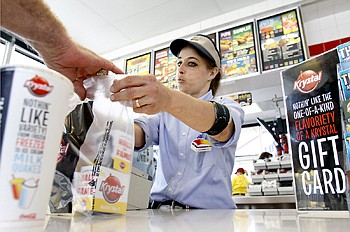Countdown on calories
Saturday, April 3, 2010
Soon, price won't be the only number next to your favorite value meal.
A requirement nestled in the recently passed health care reform bill calls for restaurants nationwide with 20 or more locations to prominently display calorie information on all menus -- including menu boards and drive-throughs.
Restaurant industry representatives have both supported and condemned the mandate. Meanwhile, locally based chains planning for regulations that the U.S. Food and Drug Administration has one year to write.
"Unfortunately, I don't think part of this bill included funds for us to make the menu boards bigger," said Brad Wahl, vice president of marketing for Chattanooga-based Krystal restaurants. "But we're going to have to figure out how to include that information within the constraints of the menu board sizes that we have."
Mr. Wahl said the company will adjust the content and layout of menu boards and drive-through menus to include the necessary information. What is still unclear, he said, is how the calorie counts will be calculated and displayed, since the total calories in a combination meal can change significantly based on drink variations.
Even before health care reform passed, similar calorie labeling legislation already was in effect in New York City, Philadelphia, San Francisco and Seattle, among other locations. Restaurants such as McDonald's, Subway and Panera Bread already post the calorie information on menus in those areas.
Tom Krings is operating partner for CSC Investments of Cleveland, Tenn., a local Panera Bread franchisee. He said that, based on experiences in markets already requiring calorie labeling, there isn't a significant effect on business.
"We've learned it's much ado about nothing," Mr. Krings said. "There's such a limited percentage of people that care about the calories being on there. The funny part is, some of the items that we serve are very healthy, there's no question about it, and some have very high calorie counts -- there's never been a secret about that."
The cost of printing new menus and menu boards is minimal, he said, since the company -- and most other restaurants -- reprints menus three to four times a year anyway.
Allen Corey, chief executive of Chattanooga-based Gordon Biersch Brewery Restaurant Group, which owns Big River Grille, called the new standards "ridiculous" and unfair to companies like his that have more than 20 locations.
"If you are going to do it, why would you opt anyone out?" Mr. Corey asked. "It's just crazy that we have to go to all of the time and effort to meet this requirement, but the restaurant down the road doesn't have to just because they don't have 20 or more units."
Gordon Biersch operates 37 restaurants, including one in San Francisco where a menu disclosure ordinance took effect in 2008.
"It's a big burden; it's very expensive, but we'll do it," Mr. Corey said.
Spokesmen for restaurants that don't now have locations in areas where calorie labeling is in place are hesitant to predict effects from the new regulation.
Representatives from Maryville, Tenn.-based Ruby Tuesday and Lebanon, Tenn.-based Cracker Barrel said they couldn't speculate about future behavior, but they don't expect negative consequences.
Pat Warner, marketing director for Georgia-based Waffle House restaurants, said the company has been watching reactions at similar establishments in New York City in attempts to gauge how it will fare.
"Whatever the outcome of this is, obviously we will adapt," Mr. Warner said.
Staff writer Dave Flessner contributed to this report.
COUNTING CALORIES
* 590: Cheese Krystal, fries and small Coke
* 940: Chick-fil-A chicken sandwich, medium waffle fries and medium sweet tea
* 1,100: McDonald's Quarter Pounder with cheese, medium fries and medium Sprite
* 1,628: Ruby Tuesday parmesan chicken pasta
Source: Restaurant Web sites
CALORIE COUNTERS ON THE WEB
www.calorieking.com
www.nutritiondata.com
www.calorielab.com
